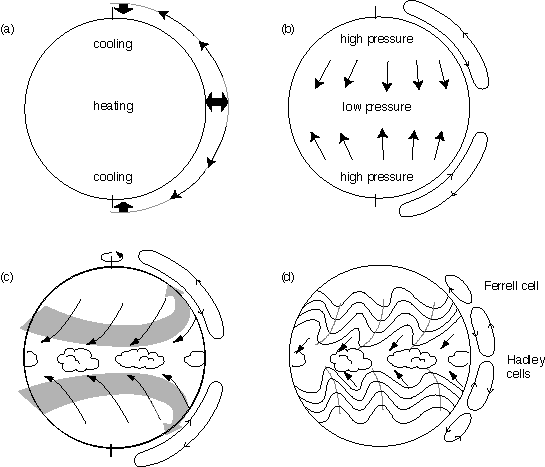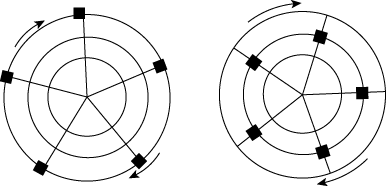Climate and Climate Change
The poleward transport of heat by atmospheric motions
Let's consider a simplified 'Earth like' planet which has net radiative heating at the Tropics and cooling at the poles. To deduce what the climate of such a simplified planet would look like we rely on experiments that have been performed with numerical models of the atmospheric component of the climate system. When realistic land-sea geometry, mountains, and seasonal changes in solar heating are prescribed in these models, they yield quite realistic simulations of the observed climate. Therefore the model simulations of our idealized Earth-like planet should have some credibility.
Simplified Earth-like planet with net heating at the tropics
When such a model atmosphere is 'turned
on', starting from a state of rest (no winds, horizontally uniform temperatures)
the tropics warm and the polar regions cool in response to the imposed
latitudinal contrast in the sun's heating, which is prescribed in a way
that mimics that in the real atmosphere. Let's assume that
when the heating is first turned in, the atmosphere is not rotating.
The ensuing sequence of events is depicted schematically in Fig. 1:

Fig. 1 Schematic depiction
of the development of the atmospheric circulation,
starting from a state of rest.
The equator-to-pole contrast in incoming solar radiation cause the tropics to warm and the high latitudes to cool. The temperature changes are largest in the troposphere, which extends to about 10 km. As the tropical troposphere warms, thermal expansion causes the air at the 10 km level to bulge upward relative to the cooling air at the higher latitudes, as represented by the heavy arrows in panel (a) of Fig. 3. Hence, the mass of air weighing down on the 10 km level increases in the tropics and decreases in high latitudes. The uneven weight of the air gives rise to a pressure gradient, which pushes the air poleward, as depicted in panel (a) of the figure.
The poleward flow of air in the upper troposphere causes air to 'pile up' at the higher latitudes. The increasing weight of the overlying air column causes sea level pressure to rise at high latitudes, while the sea-level pressure at low latitudes decreases by an equal amount. The equator-to-pole contrast in sea-level pressure drives a compensating low level flow toward equator as depicted in panel (b) of the figure. Together, the poleward high level flow and the low level equatorward flow make up a giant circulation cell extending all the way from equator to pole, with rising motion in the tropics and inking at high latitudes, as shown on the right hand side of panel (b). We can imagine that the equatorial belt, where the air in the cell is rising should be wet, and the polar regions, where air is sinking should be dry.
In this manner, differences in solar heating causes equator-to-pole movement of air. We will now see how the rotation of the Earth causes East-West movements.
Simplified Earth-like planet with net
heating at the tropics + rotation
Now let's turn on the rotation and see what happens. Once the atmosphere starts to rotate, The conservation of angular momentum begins to generate a component of the flow that circulates around the earth's axis as shown in panel (c). To understand how this 'zonal' flow arises we can invoke the principle of the conservation of angular momentum. This conservation law tells us that if we view the motions in a fixed frame of reference (i.e., a frame of reference that is not rotating with the planet-- like looking down on a merry-go-round from a fixed platform located above it), the product of the zonal velocity times the radius is conserved. Hence, objects moving toward the axis of rotation will tend to rotate faster and faster, and vice versa. To demonstrate this effect on a (small) merry-go-round, position yourself on the outer edge of it spinning as fast as you can, as shown in Figure 2. Then pull yourself inward toward the center and note how the rotation rate increases. The larger your mass in proportion to the mass of the merry-go-round, the more the merry go round will speed up. To apply the principle of the conservation of angular momentum to a rotating atmosphere we simply have to note that the poleward moving air at the 10-km level should begin to rotate faster than the planet, and this excess rotation will be viewed by observers on the planet as a westerly wind component. In a similar manner, the low level equatorward return flow should rotate more slowly than the planet, and this rotation deficiency should be evident to an observer on the planet as an easterly wind component.
An alternative way of deducing that the
circulation cell pictured in Fig. 1b will give rise to westerly winds aloft
and easterly winds down near the earth's surface is to invoke the "Coriolis
force", which will be described in the lecture on the wind driven ocean
circulation.

Fig. 2 Illustration of the conservation of angular momentum as applied to a rotating object with movable weights (denoted by the black squares).
As the heating in the tropics and the cooling at lower latitudes continue, the equator-to-pole temperature contrast gradually increases, and so does the strength of the upper level westerlies. The resulting circulation in panel (c) resembles the observed circulation in some ways (i.e., like the Earth it has tradewinds and an equatorial rain belt, but it has no midlatitude westerlies and the deserts are in high latitudes rather than in the subtropics. Does the model have it wrong? No, we just have to be patient.
Development of extratropical cyclones
After a few weeks of simulated time, the
behavior of the model suddenly changes. At that point, the equator-to-pole
temperature gradient reaches a critical value which is strong enough to
support the development of extratropical cyclones. They develop as barely
perceptible undulations in the westerlies, but within a few days of simulated
time they intensify to the point where they begin to change the entire
character of the flow by transporting heat, water vapor and angular momentum
poleward. The specifics of how these changes come about is beyond
the scope of these lecture notes, but the overall effects are:
(1) the extratropical cyclones become the primary mechanism for the poleward
transport of heat in midlatitudes. Once they develop they prevent
the further buildup of the equator-to-pole temperature gradient.
Whenever the gradient gets too strong, the storms intensify and weaken
it. (2) the extratropical cyclones disturb the upper level flow in
such a way as to take angular momentum out of the tropics and deposit it
in midlatitudes. This poleward transport of angular momentum is responsible
for the maintenance of the belt of westerly winds at the Earth's surface
in midlatitudes (3) the extratropical cyclones are responsible for the
sinking motions in the subtropics which favor desert conditions and for
a secondary maxima in rainfall around 55 N and 55 S.
Panel (d) of Fig. 1 depicts the atmospheric circulation as modified by the extratropical cyclones. Note how the equator-to-pole circulation cell in the previous panel retreats to the tropics. It is known as the 'Hadley cell'. The tradewinds undergo a similar shrinkage as a result of the development of the extratropical cyclones. The desert belts separate the trades from the midlatitude westerlies.
Last
Updated:
01/22/02